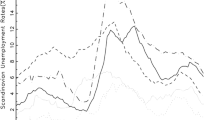Abstract
The aim of the present paper is to provide cross country evidence of the non-stationarity of hours worked for OECD countries. For this purpose, panel unit root tests are employed to improve power against univariate counterparts. Since cross section correlation is a distinct feature of the underlying panel data, results are based on various second generation panel unit root tests, which account for cross section dependence among units. If an unobserved common factor model is assumed for generating the observations, there is indication for both a common factor and idiosyncratic components driving the non-stationarity of hours worked. In addition, taking these results together, there is no indication of cointegration among the individual time series of hours worked.
Similar content being viewed by others
References
Alesina A, Glaeser E, Sacerdote B (2005) Work and leisure in the US and Europe: why so different? NBER Working Paper No. 11278
Andrews DWK, Monahan JC (1992) An improved heteroskedasticity and autocorrelation consistent covariance matrix estimator. Econometrica 60: 953–966
Bai J, Ng S (2002) Determining the number of factors in approximate factor models. Econometrica 70: 191–221
Bai J, Ng S (2004) A panic attack on unit roots and cointegration. Econometrica 72: 1127–1177
Banerjee A (1999) Panel data unit roots and cointegration: an overview. Oxford Bull Econ Stat 61: 607–629
Banerjee A, Marcellino M, Osbat C (2005) Testing for PPP: should we use panel methods? Empir Econ 30: 77–91
Blanchard O (2004) The economic future of Europe. J Econ Perspect 18(4): 3–26
Breitung J, Das S (2005) Panel unit root tests under cross sectional dependence. Stat Neerl 59: 1–20
Breitung J, Pesaran MH (2005) Unit roots and cointegration in panels. Deutsche Bundesbank Discussion Paper No. 42/2005
Choi I (2001) Unit root tests for panel data. J Int Money Finance 20: 249–272
Choi I (2004) Nonstationary panels. In: Palgrave Handbooks of econometrics, vol 1 (2004, forthcoming)
Christiano L, Eichenbaum M, Vigfusson R (2003) What happens after a technology shock? Federal Reserve Board. International Finance Discussion Papers No. 768
Christiano L, Eichenbaum M, Vigfusson R (2004) The response of hours to a technology shock: evidence based on direct measures of technology. J Eur Econ Assoc 2: 381–395
Demetrescu M, Hassler U, Tarcolea AI (2006) Combining significance of correlated statistics with application to panel data. Oxford Bull Econ Stat 68: 647–663
Elliott G, Rothenberg TJ, Stock JH (1996) Efficient tests for an autoregressive unit root. Econometrica 64: 813–836
Galí J (1999) Technology, employment, and the business cycle: do technology shocks explain aggregate fluctuations? Am Econ Rev 89: 249–271
Gengenbach C, Palm F, Urbain JP (2004) Panel unit root tests in the presence of cross-sectional dependencies: comparison and implications for modelling. Research Memoranda 040. Maastricht Research School of Economics of Technology and Organization
Gutierrez L (2006) Panel unit roots tests for cross-sectionally correlated panels: a monte carlo comparison. Oxford Bull Econ Stat 68: 519–540
Hartung J (1999) A note on combining dependent tests of significance. Biometr J 41: 849–855
Hassler U, Tarcolea AI (2005) Combining multi-country evidence on unit roots: the case of long-term interest rates. Appl Econ Q 51: 181–189
Im K, Pesaran MH, Shin Y (2003) Testing for unit roots in heterogeneous panels. J Econometr 115: 53–74
Jang MJ, Shin DW (2005) Comparison of panel unit root tests under cross sectional dependence. Econ Lett 89: 12–17
Levin A, Lin CF (1992) Unit root tests in panel data: asymptotic and finite-sample properties, U. C. San Diego Discussion Paper 92–23
Levin A, Lin CF, Chu CSJ (2002) Unit root tests in panel data: asymptotic and finite-sample properties. J Econometr 108: 1–24
McGuckin R, van Ark B (2005) Productivity and participation: an international comparison. Research Memorandum GD-78. The Conference Board and Groningen Growth and Development Centre
Moon HR, Perron B (2004) Testing for a unit root in panels with dynamic factors. J Econometr 122: 81–126
Nickell SJ, Nunziata L (2001) Labour market institutions database, Centre for Economic Performance. London School of Economics, London
O’Connell PGJ (1998) The overvaluation of purchasing power parity. J Int Econ 44: 1–19
Pesaran MH (2004) General diagnostic tests for cross section dependence in panels. CESifo Working Paper No. 1229
Pesaran MH (2007) A simple panel unit root test in the presence of cross section dependence. J Appl Econometr 22: 265–312
Pesaran MH, Shin Y, Smith RP (1999) Pooled mean group estimation of dynamic heterogeneous panels. J Am Stat Assoc 94: 621–634
Phillips PCB, Sul D (2003) Dynamic panel estimation and homogeneity testing under cross section dependence. Econometr J 6: 217–259
Prescott EC (2004) Why do americans work so much more than europeans? Federal Reserve Bank Minneapolis Q Rev 28: 2–13
Strauss J, Yigit T (2003) Shortfalls of panel unit root testing. Econ Lett 81: 309–313
The Conference Board and Groningen Growth and Development Centre (2006) Total economy database, January
Author information
Authors and Affiliations
Corresponding author
Rights and permissions
About this article
Cite this article
Kappler, M. Do hours worked contain a unit root? Evidence from panel data. Empir Econ 36, 531–555 (2009). https://doi.org/10.1007/s00181-008-0210-5
Received:
Accepted:
Published:
Issue Date:
DOI: https://doi.org/10.1007/s00181-008-0210-5



